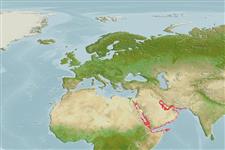>
Eupercaria/misc (Various families in series Eupercaria) >
Sparidae (Porgies)
Etymology: Acanthopagrus: Greek, akantha = thorn + Greek, pagros, a kind of fish (Ref. 45335).
More on author: Forsskål.
Environment: milieu / climate zone / depth range / distribution range
Ecología
marino; salobre asociado a arrecife; rango de profundidad 2 - 20 m (Ref. 9710). Tropical; 32°N - 10°N, 33°E - 65°E (Ref. 95256)
Western Indian Ocean: Red Sea (Israel, Egypt, Eritrea, Saudi Arabia), Persian Gulf (Bahrain and Kuwait), off southern Oman (not Gulf of Oman); presumably along the whole southern coast of the Arabian Peninsula, also Iran to Pakistan.
Length at first maturity / Tamaño / Peso / Age
Maturity: Lm 26.4 range ? - ? cm
Max length : 36.2 cm SL macho / no sexado; (Ref. 95256); common length : 40.0 cm TL macho / no sexado; (Ref. 5450); edad máxima reportada: 19 años (Ref. 3625)
Espinas dorsales (total): 11; Radios blandos dorsales (total): 12-15; Espinas anales 3; Radios blandos anales: 10 - 11. This species is distinguished from its congeners by the following set of characters: 2 conspicuous vertical black bars across the head, with the first bar from occiput through eye and across cheek to rear end of maxilla. while the second bar is from nape to opercle; colour of dorsal and caudal fins yellow, without dense black margin of dorsal-fin or narrow black edge along rear margin of caudal fin; scale rows from 5th dorsal fin spine to lateral line 5 ½ or 6 ½ ; base of dorsal and anal fins are scaly; naked interorbital area and preopercle flange; along each side of upper jaw with 2 rows of molars, with the outer molar teeth row extending to rear end of both jaws; basal width of incisor teeth (usually 6) at front of upper jaw smaller, 0.7?0.8 mm for 15 cm SL fish and 2.2?2.5 mm for fish of 34 cm SL, respectively; D XI,12?15, no elongated spines; A III,10?11, with the 2nd and 3rd anal-fin spines subequal and not enlarged (Ref. 95256).
Occur in small groups. (Ref. 9710). Marketed fresh or dried.
Iwatsuki, Y. and P.C. Heemstra, 2011. A review of the Acanthopagrus bifasciatus species complex (Pisces: Sparidae) from the Indian Ocean, with redescription of A. bifasciatus (Forsskål 1775) and A. catenula (Lacepède 1801). Zootaxa 3025:38-50. (Ref. 95256)
IUCN Red List Status (Ref. 130435)
Threat to humans
Harmless
Human uses
Pesquerías: escaso valor comercial
Más información
ReferenciasAcuiculturaPerfil de acuiculturaRazasGenéticaElectrophoresesheritabilidadEnfermedadesProcesamientoNutrientsMass conversion
Herramientas
Special reports
Download XML
Fuentes de Internet
Estimates based on models
Preferred temperature (Ref.
123201): 25 - 29.2, mean 27.6 °C (based on 323 cells).
Phylogenetic diversity index (Ref.
82804): PD
50 = 0.5000 [Uniqueness, from 0.5 = low to 2.0 = high].
Bayesian length-weight: a=0.01549 (0.00977 - 0.02454), b=3.03 (2.90 - 3.16), in cm total length, based on LWR estimates for this species & (Sub)family-body (Ref.
93245).
Nivel trófico (Ref.
69278): 3.4 ±0.43 se; based on food items.
Resiliencia (Ref.
120179): Medio, población duplicada en un tiempo mínimo de 1.4-4.4 años (K=0.18; tmax=19).
Fishing Vulnerability (Ref.
59153): Moderate vulnerability (37 of 100).
Climate Vulnerability (Ref.
125649): High to very high vulnerability (67 of 100).
Nutrients (Ref.
124155): Calcium = 57.6 [28.0, 94.1] mg/100g; Iron = 0.603 [0.332, 1.093] mg/100g; Protein = 19.9 [18.7, 21.2] %; Omega3 = 0.149 [0.097, 0.240] g/100g; Selenium = 22.9 [12.0, 42.3] μg/100g; VitaminA = 81.8 [22.8, 247.2] μg/100g; Zinc = 1.48 [1.01, 2.10] mg/100g (wet weight);
